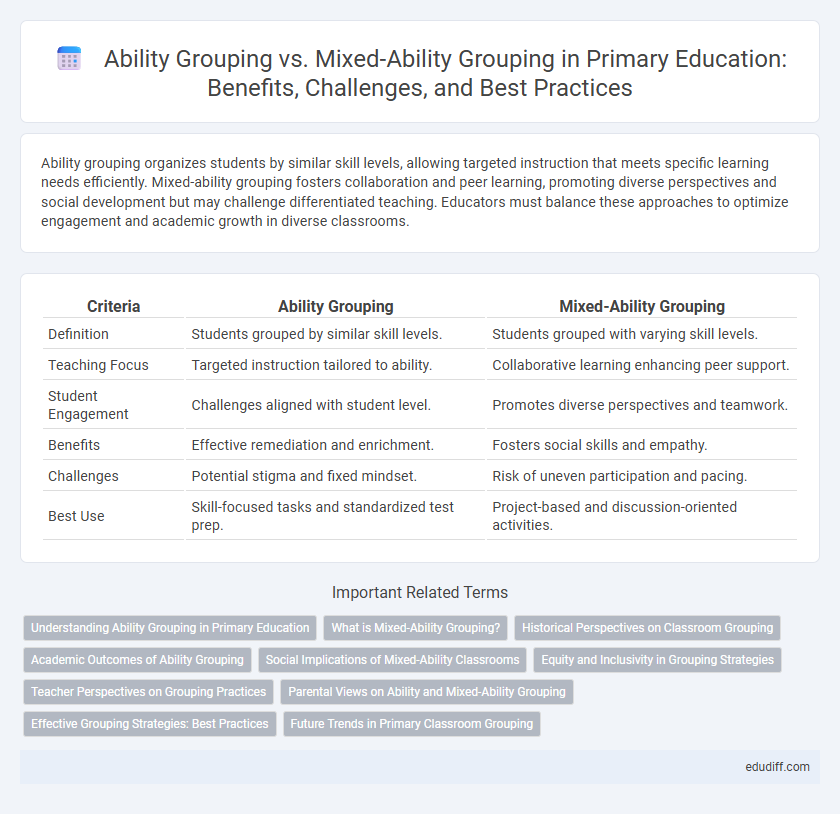Ability grouping organizes students by similar skill levels, allowing targeted instruction that meets specific learning needs efficiently. Mixed-ability grouping fosters collaboration and peer learning, promoting diverse perspectives and social development but may challenge differentiated teaching. Educators must balance these approaches to optimize engagement and academic growth in diverse classrooms.
Table of Comparison
| Criteria | Ability Grouping | Mixed-Ability Grouping |
|---|---|---|
| Definition | Students grouped by similar skill levels. | Students grouped with varying skill levels. |
| Teaching Focus | Targeted instruction tailored to ability. | Collaborative learning enhancing peer support. |
| Student Engagement | Challenges aligned with student level. | Promotes diverse perspectives and teamwork. |
| Benefits | Effective remediation and enrichment. | Fosters social skills and empathy. |
| Challenges | Potential stigma and fixed mindset. | Risk of uneven participation and pacing. |
| Best Use | Skill-focused tasks and standardized test prep. | Project-based and discussion-oriented activities. |
Understanding Ability Grouping in Primary Education
Ability grouping in primary education involves organizing students based on their skill levels to tailor instruction more effectively and address varied learning needs. This method enables targeted teaching strategies that can enhance student engagement and improve academic outcomes by matching tasks to learners' proficiency. While it supports personalized learning, careful implementation is necessary to prevent negative effects on self-esteem and peer dynamics.
What is Mixed-Ability Grouping?
Mixed-ability grouping involves organizing students with diverse skill levels into the same learning environment to promote peer collaboration and inclusive education. This approach encourages differentiated instruction tailored to varying competencies, fostering critical thinking and social development among all students. Research indicates that mixed-ability settings can enhance overall academic performance and reduce stigma associated with ability-based separation.
Historical Perspectives on Classroom Grouping
Historical perspectives on classroom grouping reveal that ability grouping, also known as tracking, emerged in the early 20th century as a method to tailor instruction based on student proficiency levels. Mixed-ability grouping gained prominence in the late 20th century, emphasizing diversity and collaborative learning among students with varying skill levels. Research from institutions like the National Education Association highlights ongoing debates about equity, effectiveness, and social outcomes associated with both grouping strategies.
Academic Outcomes of Ability Grouping
Ability grouping in educational settings often leads to higher academic outcomes for students placed in advanced groups, as tailored instruction matches their proficiency levels more precisely. Research indicates that ability grouping can improve standardized test scores and enhance subject mastery, particularly in mathematics and reading. However, the benefits are most pronounced when grouping is flexible and regularly reassessed to address individual learning progress.
Social Implications of Mixed-Ability Classrooms
Mixed-ability classrooms foster inclusive social environments by encouraging collaboration among students with diverse skills, which enhances empathy and reduces stigmatization often seen in ability grouping. Students in mixed-ability settings develop stronger communication and teamwork skills as they learn to support peers with varying levels of understanding. This social dynamic helps create a more equitable classroom culture, promoting respect and cohesion across different ability levels.
Equity and Inclusivity in Grouping Strategies
Ability grouping segments students by skill level, which can lead to inequities by limiting access to diverse perspectives and reinforcing achievement gaps. Mixed-ability grouping fosters inclusivity by promoting collaboration among students with varied strengths, encouraging peer learning and social cohesion. Equity in grouping strategies is enhanced when educators implement mixed-ability groups that support differentiated instruction and address diverse learner needs.
Teacher Perspectives on Grouping Practices
Teachers often perceive ability grouping as a strategy that allows tailored instruction to students with similar skill levels, facilitating targeted support and pacing adjustments. Mixed-ability grouping is valued for promoting peer collaboration and social learning, encouraging diverse problem-solving approaches. Educators express concerns about the potential stigmatization and fixed mindsets associated with ability grouping, while recognizing the challenge of balancing individual needs within mixed-ability settings.
Parental Views on Ability and Mixed-Ability Grouping
Parents often perceive ability grouping as a way to tailor instruction to their child's skill level, believing it can boost academic achievement through focused teaching. Conversely, some parents express concerns that ability grouping may reinforce social divisions and limit peer interaction, favoring mixed-ability grouping for its potential to promote inclusivity and diverse learning experiences. Research indicates that parental support for mixed-ability grouping increases when they recognize benefits such as collaborative learning and enhanced social skills among children.
Effective Grouping Strategies: Best Practices
Effective grouping strategies prioritize student engagement and differentiated instruction by aligning tasks with individual readiness levels to maximize learning outcomes. Ability grouping enhances targeted skill development through tailored challenges, while mixed-ability grouping fosters peer collaboration and diverse perspectives, promoting social skills and critical thinking. Combining data-driven assessment and flexible grouping arrangements ensures adaptability to student needs, optimizing both academic advancement and inclusive classroom dynamics.
Future Trends in Primary Classroom Grouping
Future trends in primary classroom grouping emphasize the integration of adaptive technology to tailor instruction in both ability grouping and mixed-ability settings. Research highlights the growing use of AI-driven platforms that analyze student performance data to dynamically adjust group compositions, enhancing personalized learning outcomes. Educators increasingly prioritize flexibility, combining ability grouping for targeted skill development with mixed-ability groups to foster collaboration and social skills.
Ability Grouping vs Mixed-Ability Grouping Infographic

 edudiff.com
edudiff.com